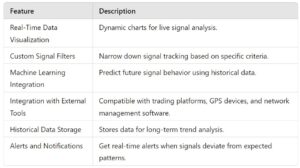Signal tracking is a powerful tool for individuals and businesses looking to monitor and analyze signals in various environments, such as telecommunications, trading, and GPS navigation. Signal Tracker ZZZ is an advanced platform that allows users to track, visualize, and analyze signals in real-time, offering critical insights into signal patterns, anomalies, and trends. In this comprehensive guide, we’ll walk you through the process of setting up a Signal Tracker, discuss its key features, and provide actionable tips to maximize its effectiveness.
Table of Contents
- Introduction to Signal Tracking
- Why Use Signal Tracker ZZZ?
- Key Features of Signal Tracker ZZZ
- Step-by-Step Guide to Setting Up Signal Tracker ZZZ
- Best Practices for Maximizing Signal Tracker ZZZ Performance
- Expert Tips on Signal Analysis
- Conclusion
1. Introduction to Signal Tracking
Signal tracking refers to the process of monitoring and capturing signals in specific ranges, whether they are radio waves, trading signals, or location-based signals. This information is then analyzed to provide insights, identify issues, or enhance the efficiency of operations. Signal tracking is widely used in industries such as:
- Telecommunications: To monitor network quality and bandwidth.
- Trading: To analyze market trends.
- GPS Navigation: To ensure accurate location tracking.
As the demand for real-time data grows, so does the importance of sophisticated tools like Signal Tracker ZZZ to help professionals and businesses stay ahead.
2. Why Use Signal Tracker ZZZ?
There are numerous signal trackers available, but Signal Tracker stands out due to its versatility, ease of use, and comprehensive feature set. Here’s why it’s a preferred choice:
- Real-Time Tracking: The ZZZ signal tracker provides real-time data, enabling users to make immediate decisions based on the latest information.
- Customizable Dashboards: Users can create custom views and dashboards to focus on the metrics that matter most.
- Alerts and Notifications: Get notified when signals deviate from expected patterns, ensuring timely intervention.
- Cross-Platform Compatibility: Whether you’re on a desktop, tablet, or smartphone, Signal Tracker ZZZ works seamlessly across platforms.
3. Key Features of Signal Tracker ZZZ
Real-Time Data Visualization
Signal Tracker ZZZ offers dynamic and interactive charts, making it easy to visualize signal strength, frequency, and other metrics in real time.
Custom Signal Filters
Users can apply custom filters to isolate specific signals for a more focused analysis, allowing them to track only what is relevant to their needs.
Machine Learning Integration
Leveraging machine learning, Signal Tracker ZZZ can identify patterns and predict future signal behavior based on historical data.
Integration with External Tools
It supports integration with other software, such as trading platforms and network management tools, allowing for a unified signal management experience.
Historical Data Storage
Signal Tracker ZZZ allows users to store and access historical data, which is essential for long-term analysis and reporting.
4. Step-by-Step Guide to Setting Up Signal Tracker ZZZ
Step 1: Create an Account
Before using Signal Tracker ZZZ, you need to register for an account. This involves providing basic information like your name, email address, and selecting a subscription plan based on your needs.
Step 2: Configure Your Dashboard
Once logged in, you’ll be taken to the dashboard. Here, you can customize the layout by adding widgets for specific signal types or metrics. Consider adding charts, signal strength meters, and alerts to monitor performance efficiently.
Step 3: Set Up Signal Sources
You’ll need to configure the signal sources you want to track. This could be:
- Wi-Fi or Mobile Networks for telecommunications.
- Financial Markets for trading signals.
- GPS Devices for location tracking.
Input the relevant source information, including frequency ranges or market symbols, to enable tracking.
Step 4: Apply Custom Filters
Use filters to narrow down the signal data. This might include isolating signals from a specific geographic region, frequency range, or market. Filters are critical to avoiding data overload and focusing on key insights.
Step 5: Set Up Alerts and Notifications
Navigate to the Alerts section to set thresholds. For example:
- Get notified when signal strength falls below a certain dBm.
- Receive alerts when a trading signal crosses a specified price threshold.
These notifications can be sent via email, SMS, or in-app notifications.
Step 6: Monitor and Analyze
After completing your setup, start monitoring the data. Use the customizable dashboards and real-time charts to analyze signals. You can also access historical data to identify trends over time.
Step 7: Export Data for Reporting
Signal Tracker ZZZ allows you to export data into various formats, such as CSV or PDF, for reporting or sharing with team members.
5. Best Practices for Maximizing Signal Tracker ZZZ Performance
To get the most out of a Signal Tracker , follow these best practices:
- Set Appropriate Thresholds: Over-alerting can lead to notification fatigue. Ensure that you set realistic thresholds for alerts to avoid constant interruptions.
- Regularly Review Historical Data: Don’t rely solely on real-time data. Regularly review stored historical data to better understand trends and predict future signal behavior.
- Update Filters Regularly: As your needs evolve, so should your filters. Periodically review and update your filters to keep them relevant.
6. Expert Tips on Signal Analysis
Use Multiple Sources for Signal Verification
To improve accuracy, use multiple sources for cross-verifying signals. For instance, if you’re tracking GPS signals, combine them with mobile tower signals to ensure accuracy.
Leverage AI for Predictive Analysis
Machine learning algorithms can help predict future signal behaviors based on historical patterns. This is especially useful in fields like financial trading, where predicting market trends is crucial.
Stay Updated on Signal Protocols
Different industries use varying signal protocols. Staying informed about the latest updates in your field, such as the introduction of new frequency bands in telecommunications, will enhance the effectiveness of your tracking.
7. Conclusion
Setting up a Signal Tracker can significantly enhance your ability to monitor and analyze signals, whether for telecommunications, trading, or GPS navigation. With real-time tracking, customizable dashboards, and advanced features like machine learning integration, Signal Tracker ZZZ provides a robust platform for signal analysis. By following the step-by-step guide outlined above, you can set up your tracker in no time and start leveraging its powerful features to gain actionable insights.
Key Takeaways:
- Real-time tracking allows for immediate decision-making.
- Customizable dashboards ensure that you see only the most relevant data.
- Machine learning integration enhances signal analysis by predicting future trends





